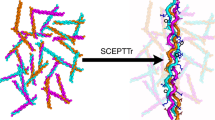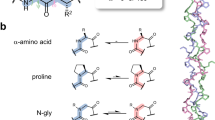Abstract
THE two models of collagen structure which have been developed since 1954 have been confirmed by X-ray diffraction studies of the collagen fibres. Both models are similar, the chief difference being in the number of hydrogen bonds. Rich and Crick1 assumed that there was one hydrogen bond for each tripeptide unit (one bonded structure) while Ramachandran2 assumed two hydrogen bonds per unit (two bonded structure) in the structure he suggested. Thus differences in the sequence of the amino-acids and changes in the position of atoms are unavoidable. In the collagen structure II of Rich and Crick, position 1 of the tripeptide unit is always occupied by a glycine unit; the positions 2 and 3 may be occupied by any other amino-acid including proline and hydroxyproline. On the other hand, in the Ramachandran structure an imino-acid unit can only occupy position 3 if changes in the collagen structure are to be avoided. The results obtained by Harrington3 and Bensusan and Nielsen4 support the structure proposed by Ramachandran. Investigations into synthetic polypeptides composed of tripeptide units, such as gly-pro-hypro5,6 and pro-gly-pro7, have shown that only one hydrogen bond per tripeptide unit is sufficient for the formation of a collagen like structure in solution as well as in the solid state.
This is a preview of subscription content, access via your institution
Access options
Subscribe to this journal
Receive 51 print issues and online access
$199.00 per year
only $3.90 per issue
Buy this article
- Purchase on Springer Link
- Instant access to full article PDF
Prices may be subject to local taxes which are calculated during checkout
Similar content being viewed by others
References
Rich, A., and Crick, F. H., J. Mol. Biol., 3, 483 (1961).
Ramachandran, G. N., and Sasisekharan, V., Nature, 190, 1004 (1961).
Harrington, W. F., J. Mol. Biol., 9, 613 (1964).
Bensusan, H. B., and Nielsen, S. O., Biochemistry, 3, 1367 (1964).
Andreeva, N. S., Millionova, M. J., and Chirgadse, Y. N., in Aspects of Protein Structure (edit. by Ramachandran, G. N.), 137 (Academic Press, London, New York, 1963).
Rogulenkova, V. N., Millionova, M. J., and Andreeva, N. S., J. Mol. Biol., 9, 253 (1964).
Engel, J., Kurtz, J., Katchalski, E., and Berger, A., J. Mol. Biol., 17, 255 (1965).
Kitaoka, H., Sakakibara, S., and Tani, H., Bull. Chem. Soc., Japan, 31, 802 (1958).
Blout, E. R., DeLoze, C., and Asadourian, A., J. Amer. Chem. Soc., 83, 1895 (1961).
Heidemann, E., and Srinivasan, S., Leder, 18, 145 (1967).
Heidemann, E., and Riess, W., Hoppe Seyler's Z. Physiol. Chem., 337, 101 (1964).
Author information
Authors and Affiliations
Rights and permissions
About this article
Cite this article
HEIDEMANN, E., BERNHARDT, H. Deuterium–Hydrogen Exchange of Collagen Like Synthetic Polypeptides. Nature 216, 263–264 (1967). https://doi.org/10.1038/216263a0
Received:
Revised:
Issue Date:
DOI: https://doi.org/10.1038/216263a0
This article is cited by
-
Synthetic Polypeptides as Models for Collagen
Nature (1968)
Comments
By submitting a comment you agree to abide by our Terms and Community Guidelines. If you find something abusive or that does not comply with our terms or guidelines please flag it as inappropriate.



